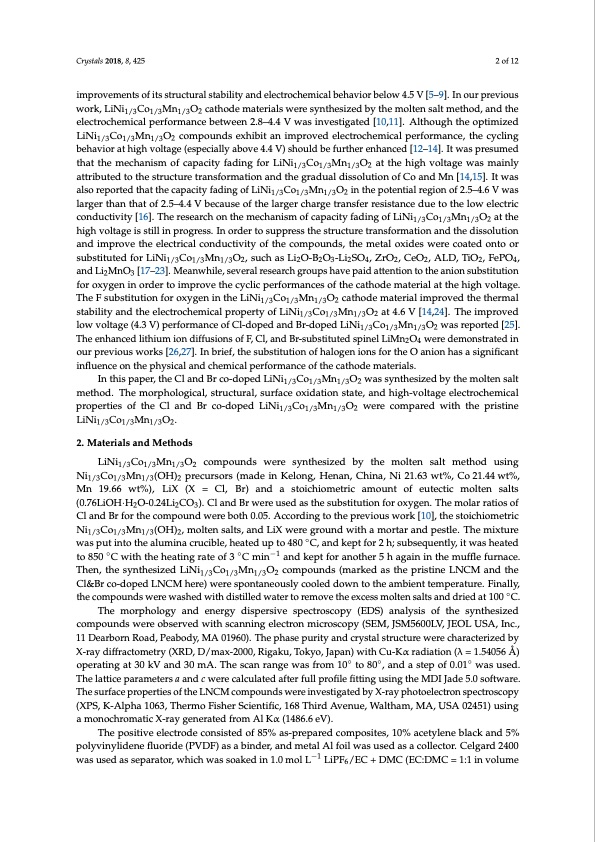
PDF Publication Title:
Text from PDF Page: 002
Crystals 2018, 8, 425 2 of 12 improvements of its structural stability and electrochemical behavior below 4.5 V [5–9]. In our previous work, LiNi1/3Co1/3Mn1/3O2 cathode materials were synthesized by the molten salt method, and the electrochemical performance between 2.8–4.4 V was investigated [10,11]. Although the optimized LiNi1/3Co1/3Mn1/3O2 compounds exhibit an improved electrochemical performance, the cycling behavior at high voltage (especially above 4.4 V) should be further enhanced [12–14]. It was presumed that the mechanism of capacity fading for LiNi1/3Co1/3Mn1/3O2 at the high voltage was mainly attributed to the structure transformation and the gradual dissolution of Co and Mn [14,15]. It was also reported that the capacity fading of LiNi1/3Co1/3Mn1/3O2 in the potential region of 2.5–4.6 V was larger than that of 2.5–4.4 V because of the larger charge transfer resistance due to the low electric conductivity [16]. The research on the mechanism of capacity fading of LiNi1/3Co1/3Mn1/3O2 at the high voltage is still in progress. In order to suppress the structure transformation and the dissolution and improve the electrical conductivity of the compounds, the metal oxides were coated onto or substituted for LiNi1/3Co1/3Mn1/3O2, such as Li2O-B2O3-Li2SO4, ZrO2, CeO2, ALD, TiO2, FePO4, and Li2MnO3 [17–23]. Meanwhile, several research groups have paid attention to the anion substitution for oxygen in order to improve the cyclic performances of the cathode material at the high voltage. The F substitution for oxygen in the LiNi1/3Co1/3Mn1/3O2 cathode material improved the thermal stability and the electrochemical property of LiNi1/3Co1/3Mn1/3O2 at 4.6 V [14,24]. The improved low voltage (4.3 V) performance of Cl-doped and Br-doped LiNi1/3Co1/3Mn1/3O2 was reported [25]. The enhanced lithium ion diffusions of F, Cl, and Br-substituted spinel LiMn2O4 were demonstrated in our previous works [26,27]. In brief, the substitution of halogen ions for the O anion has a significant influence on the physical and chemical performance of the cathode materials. In this paper, the Cl and Br co-doped LiNi1/3Co1/3Mn1/3O2 was synthesized by the molten salt method. The morphological, structural, surface oxidation state, and high-voltage electrochemical properties of the Cl and Br co-doped LiNi1/3 Co1/3 Mn1/3 O2 were compared with the pristine LiNi1/3 Co1/3 Mn1/3 O2 . 2. Materials and Methods LiNi1/3 Co1/3 Mn1/3 O2 compounds were synthesized by the molten salt method using Ni1/3Co1/3Mn1/3(OH)2 precursors (made in Kelong, Henan, China, Ni 21.63 wt%, Co 21.44 wt%, Mn 19.66 wt%), LiX (X = Cl, Br) and a stoichiometric amount of eutectic molten salts (0.76LiOH·H2O-0.24Li2CO3). Cl and Br were used as the substitution for oxygen. The molar ratios of Cl and Br for the compound were both 0.05. According to the previous work [10], the stoichiometric Ni1/3Co1/3Mn1/3(OH)2, molten salts, and LiX were ground with a mortar and pestle. The mixture was put into the alumina crucible, heated up to 480 ◦C, and kept for 2 h; subsequently, it was heated to 850 ◦C with the heating rate of 3 ◦C min−1 and kept for another 5 h again in the muffle furnace. Then, the synthesized LiNi1/3Co1/3Mn1/3O2 compounds (marked as the pristine LNCM and the Cl&Br co-doped LNCM here) were spontaneously cooled down to the ambient temperature. Finally, the compounds were washed with distilled water to remove the excess molten salts and dried at 100 ◦C. The morphology and energy dispersive spectroscopy (EDS) analysis of the synthesized compounds were observed with scanning electron microscopy (SEM, JSM5600LV, JEOL USA, Inc., 11 Dearborn Road, Peabody, MA 01960). The phase purity and crystal structure were characterized by X-ray diffractometry (XRD, D/max-2000, Rigaku, Tokyo, Japan) with Cu-Kα radiation (λ = 1.54056 Å) operating at 30 kV and 30 mA. The scan range was from 10◦ to 80◦, and a step of 0.01◦ was used. The lattice parameters a and c were calculated after full profile fitting using the MDI Jade 5.0 software. The surface properties of the LNCM compounds were investigated by X-ray photoelectron spectroscopy (XPS, K-Alpha 1063, Thermo Fisher Scientific, 168 Third Avenue, Waltham, MA, USA 02451) using a monochromatic X-ray generated from Al Kα (1486.6 eV). The positive electrode consisted of 85% as-prepared composites, 10% acetylene black and 5% polyvinylidene fluoride (PVDF) as a binder, and metal Al foil was used as a collector. Celgard 2400 was used as separator, which was soaked in 1.0 mol L−1 LiPF6/EC + DMC (EC:DMC = 1:1 in volumePDF Image | Enhanced High Voltage Performance of Chlorine Bromine

PDF Search Title:
Enhanced High Voltage Performance of Chlorine BromineOriginal File Name Searched:
crystals-08-00425.pdfDIY PDF Search: Google It | Yahoo | Bing
Product and Development Focus for Salgenx
Redox Flow Battery Technology: With the advent of the new USA tax credits for producing and selling batteries ($35/kW) we are focussing on a simple flow battery using shipping containers as the modular electrolyte storage units with tax credits up to $140,000 per system. Our main focus is on the salt battery. This battery can be used for both thermal and electrical storage applications. We call it the Cogeneration Battery or Cogen Battery. One project is converting salt (brine) based water conditioners to simultaneously produce power. In addition, there are many opportunities to extract Lithium from brine (salt lakes, groundwater, and producer water).Salt water or brine are huge sources for lithium. Most of the worlds lithium is acquired from a brine source. It's even in seawater in a low concentration. Brine is also a byproduct of huge powerplants, which can now use that as an electrolyte and a huge flow battery (which allows storage at the source).We welcome any business and equipment inquiries, as well as licensing our flow battery manufacturing.| CONTACT TEL: 608-238-6001 Email: greg@salgenx.com | RSS | AMP |